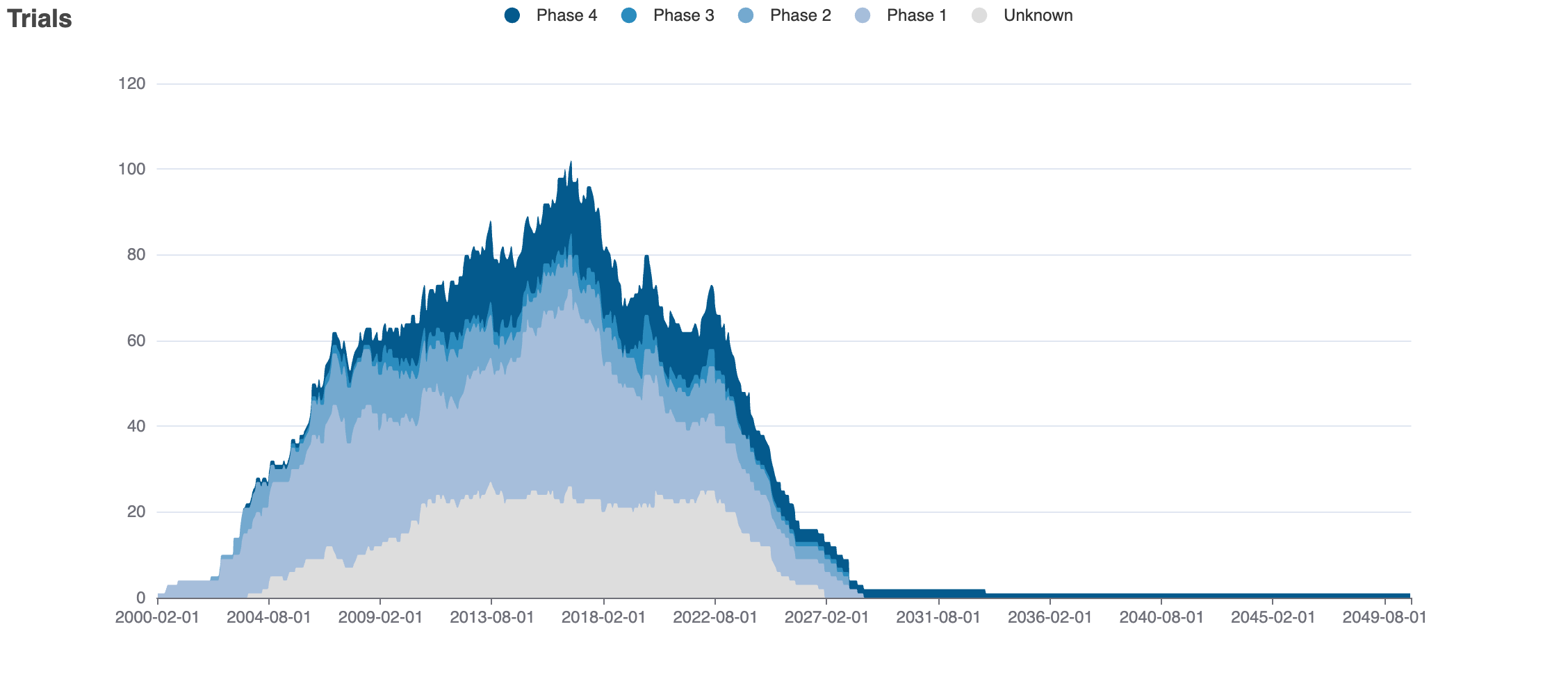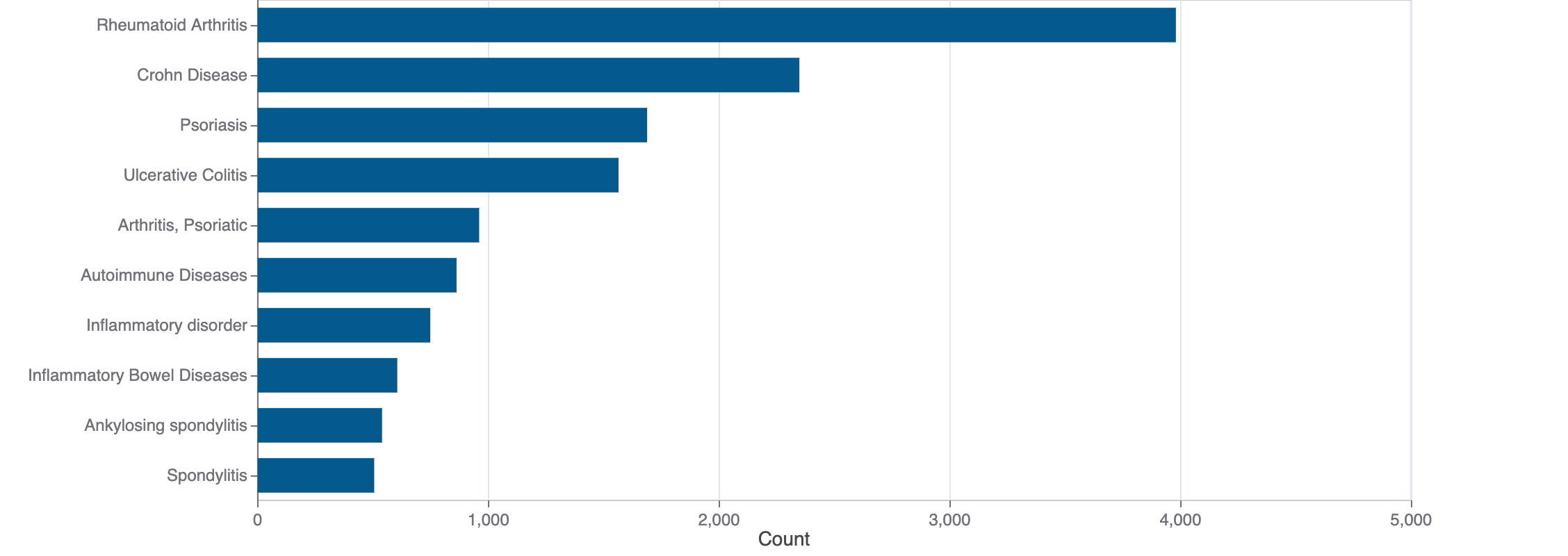Fezolinetant
Veozah (fezolinetant) is a small molecule pharmaceutical. Fezolinetant was first approved as Veozah on 2023-05-12. It is used to treat hot flashes in the USA. The pharmaceutical is active against neuromedin-K receptor.
Download report
Favorite
Events Timeline
Commercial
Clinical
Drug
Target
Variants
Financial
Trends
Safety
Events Timeline
5D
1M
3M
6M
YTD
1Y
2Y
5Y
Max
Events
FDA approval date
EMA approval date
Patent expiration date
Study first post date
Last update post date
Start date
Primary completion date
Completion date
Results first post date

Mock data
Subscribe for the real data
Subscribe for the real data
Commercial
Therapeutic Areas
Therapeutic Area | MeSH |
|---|---|
| signs and symptoms pathological conditions | D013568 |
Trade Name
FDA
EMA
Veozah
Drug Products
FDA
EMA
New Drug Application (NDA)
New Drug Application (NDA)
Abbreviated New Drug Application (ANDA)
Abbreviated New Drug Application (ANDA)
Fezolinetant
Tradename | Company | Number | Date | Products |
|---|---|---|---|---|
| VEOZAH | Astellas Pharma | N-216578 RX | 2023-05-12 | 1 products, RLD, RS |
Labels
FDA
EMA
Brand Name | Status | Last Update |
|---|---|---|
| veozah | New Drug Application | 2024-12-27 |
Indications
FDA
EMA
Indication | Ontology | MeSH | ICD-10 |
|---|---|---|---|
| hot flashes | — | D019584 | — |
Agency Specific
FDA
EMA
Expiration | Code | ||
|---|---|---|---|
FEZOLINETANT, VEOZAH, ASTELLAS | |||
| 2028-05-12 | NCE | ||
HCPCS
No data
Clinical
Clinical Trials
25 clinical trials
View more details

Mock data
Subscribe for the real data
Subscribe for the real data
Indications Phases 4
No data
Indications Phases 3
Indication | MeSH | Ontology | ICD-10 | Ph 1 | Ph 2 | Ph 3 | Ph 4 | Other | Total |
|---|---|---|---|---|---|---|---|---|---|
| Hot flashes | D019584 | — | — | — | 6 | 10 | — | 1 | 16 |
| Menopause | D008593 | EFO_0003922 | N95 | — | 2 | 1 | — | — | 2 |
Indications Phases 2
Indication | MeSH | Ontology | ICD-10 | Ph 1 | Ph 2 | Ph 3 | Ph 4 | Other | Total |
|---|---|---|---|---|---|---|---|---|---|
| Breast neoplasms | D001943 | EFO_0003869 | C50 | — | 2 | — | — | — | 2 |
| Prostatic neoplasms | D011471 | — | C61 | — | 2 | — | — | — | 2 |
| Carcinoma | D002277 | — | C80.0 | — | 1 | — | — | — | 1 |
| Carcinoma in situ | D002278 | — | D09.9 | — | 1 | — | — | — | 1 |
| Ductal carcinoma breast | D018270 | — | — | — | 1 | — | — | — | 1 |
| Ductal carcinoma | D044584 | — | — | — | 1 | — | — | — | 1 |
| Intraductal carcinoma noninfiltrating | D002285 | — | D05.1 | — | 1 | — | — | — | 1 |
| Adenocarcinoma | D000230 | — | — | — | 1 | — | — | — | 1 |
| Multiple endocrine neoplasia type 1 | D018761 | — | E31.21 | — | 1 | — | — | — | 1 |
Indications Phases 1
Indication | MeSH | Ontology | ICD-10 | Ph 1 | Ph 2 | Ph 3 | Ph 4 | Other | Total |
|---|---|---|---|---|---|---|---|---|---|
| Healthy volunteers/patients | — | — | — | 6 | — | — | — | — | 6 |
| Liver diseases | D008107 | EFO_0001421 | K70-K77 | 1 | — | — | — | — | 1 |
| Hepatic insufficiency | D048550 | — | — | 1 | — | — | — | — | 1 |
| Renal insufficiency | D051437 | — | N19 | 1 | — | — | — | — | 1 |
Indications Without Phase
No data
Epidemiology
Epidemiological information for investigational and approved indications
View more details
Drug
General
| Drug common name | Fezolinetant |
| INN | fezolinetant |
| Description | Fezolinetant is a triazolopyrazine that is 5,6,7,8-tetrahydro[1,2,4]triazolo[4,3-a]pyrazine substituted by 3-methyl-1,2,4-thiadiazol-5-yl, 4-fluorobenzoyl and methyl groups at positions 3, 7, and 8R, respectively. It is a prescription medicine used to reduce moderate to severe vasomotor symptoms due to menopause. It has a role as a neurokinin-3 receptor antagonist. It is a member of monofluorobenzenes, a triazolopyrazine, a member of thiadiazoles, a member of benzamides and a tertiary carboxamide. |
| Classification | Small molecule |
| Drug class | tachykinin (neurokinin) receptor antagonists: NK3 receptor antagonists |
| Image (chem structure or protein) |  |
| Structure (InChI/SMILES or Protein Sequence) | Cc1nsc(-c2nnc3n2CCN(C(=O)c2ccc(F)cc2)[C@@H]3C)n1 |
Identifiers
| PDB | — |
| CAS-ID | 1629229-37-3 |
| RxCUI | — |
| ChEMBL ID | CHEMBL3608680 |
| ChEBI ID | — |
| PubChem CID | 117604931 |
| DrugBank | DB15669 |
| UNII ID | 83VNE45KXX (ChemIDplus, GSRS) |
Target
Agency Approved
TACR3
TACR3
Alternate
No data
Variants
No data
Financial
No data
Trends
PubMed Central
Top Terms for Disease or Syndrome:

Mock data
Subscribe for the real data
Subscribe for the real data
Additional graphs summarizing 220 documents
View more details
Safety
Black-box Warning
Black-box warning for: Veozah
Adverse Events
Top Adverse Reactions

Mock data
Subscribe for the real data
Subscribe for the real data
1,616 adverse events reported
View more details
© 2020-2025 Collaborative Drug Discovery Inc. (CDD) | Terms of Use